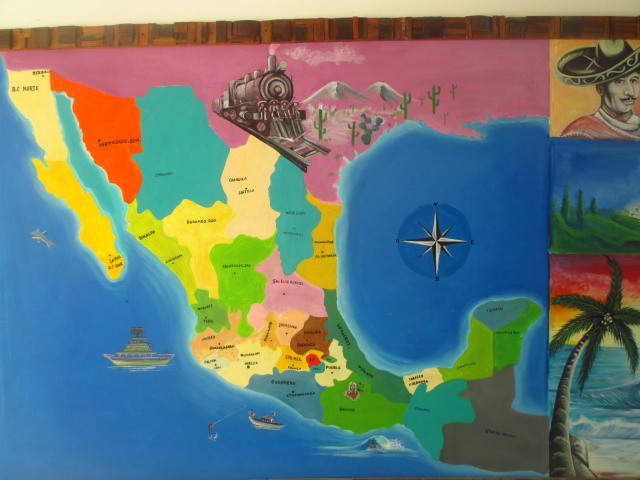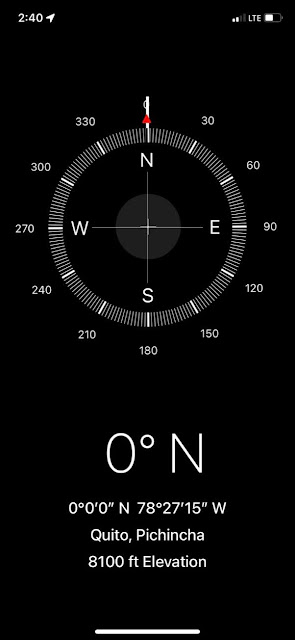Puerto Escondido
So after a month in Oaxaca City, we caught the Mexican version of the 'hound to the surfing beach town of Puerto Escondido. It was an eleven hour ride west through the super-scenic and mostly uninhabited mountain ranges of the Sierra Madre del Sur, replete with hair-pin curves and potholes, down to the beaches of the Oaxacan Pacific coast.
We rented the ground floor studio apartment of this building for US $322 for the month. It was located in the Lazaro Cardenas neighborhood. Puerto Escondido is basically two towns separated by the regional Highway 200, which runs along the upper bluff of the beaches. Lazaro is in the upper town where most of the locals live and go about their business, seemingly unaware of Ted and Lilly.
In the town below, known locally as the adoquin, most of the restaurants, hotels, bars are spread along a single touristy beachfront mall. (touristy, in a Mexican, surfer dude, sleepy beach town kind of way).
This wall was about 6 inches from the always open windows in our apartment, about seven blocks uphill from the adoquin. We loved living there: going to the market to get authentic ingredients from the women from outlaying villages to make tamales after adventure and watching the locals do their thing. They in turn I suppose, watched the gringos doing their thing.
But through that window you really
Sometimes people would stop beneath this window to gossip, having no idea that I was sitting 6 inches behind those bushes, taking Spanish quizzes on line. I would look at it as a challenge to see how much I could understand of their local Mexican conversation. I also hoped to learn something about what the senora was up to next door when hubby was away.
Many days the spectators far out number the surfers.
But Damn! if there are not a whole lot of what looks like generations of local Mexican 10 year olds that have grown up on these epic waves.
They are out there on their boogie boards, not a parent in sight, fearlessly zipping in between the surfers who hail from all over the world.
Wandering Californian surfers in the 1950's admired the Puerto Barrels from the beach, however the heavy longboards of that era were ill-equipped to handle such powerful waves. The shortboard revolution of the 1970's allowed surfers to actually start riding the Mexican Pipeline (using the faster, more challenging tube riding style originated by Gerry Lopez at the Banzai Pipeline in Hawaii).
As the hard core surfing scene moved from Malibu to Puerto, more surfers came, first in a trickle and then as access to the area improved, in a bit of a flood. Hence, the sleepy former coffee town of Hidden Port became to be not so hidden.
Playa Zicatela from the bluff leading to the beach. Home of a natural creation, the Mexican Pipeline.
Offshore, a canyon formed by the convergence of tectonic plates, funnels the swells and magnifies them into monster tubes that pound the south facing beach dead on. We could hear the crashes seven uphill blocks away.
Playa Principal, where Mexican families frolic on weekends and holidays and vacationers from everywhere appreciate Puerto Escondido. They lounge in chairs and hammocks in between the beach and the many palm tree shady and inexpensive seafood restaurants.
These restaurants are not inexpensive for working residents however, as the minimum wage is US 55 cents per hour. One can go up the hill and get the same meal for a third of the price with a view of the beach, but not on the beach,
Supposedly some of the safest swimming for people like us, but Lilly got a real wake up call from a wave here one day...sand still in her ears a week later.
One day, after a "remind me why I am doing this again moment" due to the sweltering heat, an excruciatingly long slog over soft sand, we arrived at La Punta, the east end of Puerto Escondido Bay.
Home of manageable waves, a little colony has developed for low budget wave chasers. Low budget surfers can set up shop here and lead the vagabond surfing life for weeks or months at at a time until they are ready to hike the three miles up to Zicatela and try to paddle past the notoriously powerful swells and try their luck on the pipeline.
As a side note, there is DJ Stroud, the only serious surfer that I have known. He was doing EDM and raves at Chef Ted's Shimmy Club in the early days. But his real passion was surfing and I could never figure out how he could afford to disappear to surf breaks for weeks or months at a time.
Anyhoo, I recently tracked him down to a beach in Costa Rica for a possible visit. He said "dude, Zicatela is way too gnarly for me".
If you go a little further out of Puerto, there are smaller beaches that are not as dangerous. Locals offer surfing lessons for beginners and advanced and there are a few palapa (palmed thatched open dwelling) restaurants offering mainly seafood like fish tacos. The fishermen catch the fish in boats with not much more than an outboard engine.
Here we enjoy a coco frio. I actually have had many more coconuts in Oaxaca than in Hawaii. The differences? In Hawaii, a fresh coconut is more of a treat, unless you know a coconut tree climber, they are served at ambient temperature and cost ~$5.00.
In coastal Mexico they are abundant and served icy cold. I think they must put them in a freezer, because you can go for a swim or an hour walk and upon return the coco is still refreshingly cold. Cost is ~$1.25.
Zicatela has many of these palapa style bars and restaurants. On this night, we were the only customers at this sunset Happy Hour. Busy season starts early November through February.
Walk a mile further and there is Playa Carrizalillo.
Walking to the beach one day I spot an old style comal. These wood fired griddles date back to 700 BCE and were originally thin earthenware cooking devices. Comals are used to cook tortillas, toast spices and sear meat.
In indigenous and pre-hispanic cultures, these comals de barro were handed down from grandmother to mother to daughter, the idea being that after years of constant use, they will heat faster and cook cleaner.
Now days they are metal. In my kitchen in the sky I would have the ceramic comal because I like to make things harder on myself.
So after a month, we moved out of Lazaro to Casa Amarilla a few miles away in the Playa Bococho neighborhood. At least on this street, it appears that the majority of the residents are retired ex-pats. Yanks, Canuks, Italians.
Nice pool with an electric fence on the compound wall.
View from our third floor palapa apartment.
Inside of the crib. Sea breeze is nice up here.
Meet Airbnb Superhost Steven, originally from Portland where he owned a bicycle shop. He has been in Puerto some 13 years. Steven is also a mescal aficionado (part of the reason we chose his house!). Steven buys 60 liters of tobala mescal from someone in the bush every now and again.
That gallon bottle on the table was the fine cactus juice we were working on that evening. No label, no name, no bullshit, tobala mescal.
One of the great things about Mexico for foodies is the availability of such great raw ingredients at the markets...fresh and mostly organic at ~80% discount of what you would find at a Whole Foods Wallet.
I especially like trying the heretofore unknown to me fresh herbs: pre-hispanic shit both culinary and medicinal, one in the same as their food and medicine are the same thing, that the village people bring to the Saturday market.
Casa Amarilla has an awesome kitchen with every conceivable pot and spice. As far as meals are concerned, usually everyone kinda does their own thing at different times (as there is quite a bit of laying about).
However, sometimes we have communal meals by the pool. In the picture, I am getting ready to make paella in that ceramic olla de barro. We are going to use lobsters a guy on a bicycle brought by the house, red snapper, local shrimp and veggies.
As a 45 year observer of saffron and therfore hyper-alert to any ersatz substitutions, I suspect that the package that stated: grown in Mexico azafran, alas, was actually safflower leaves, known as Mexican Saffron.
It looks just like real saffron, makes the rice yellow but has no flavor. With a few extra spoonfuls of Spanish Paprika the paella was awesome.
Grilled Al Ajo, Red Snapper later served with local limes.
Getting ready to add the rice and broth.
We are on the top floor, but also in the compound live a Ukrainian couple who have a *life coach* business on line that has kept them in Puerto for onward of two years. Having lived amongst various *life coaches* in Hawaii for many years I asked for her website Ирина Атаманенко At first she said rather cryptically that it was in Russian and I wouldn't understand. I cheerfully suggested there was always Google Translate. Hummm....I thought, maybe she had something to do with collusion and MAGA?
Turns out Not.
Meet Thomas and Martino who live on the second floor. Thomas, a retired postal worker and Viet Nam vet, lives six months of the year at Casa Amarilla and the other six months in Connecticut.
Martino is quite the character around Puerto, people yelling "Martino!!" greetings as they ride around town or walk on the beach.
Thomas relates the story of taking Martino fishing aboard one of the many fishing boats that offer their services at Playa Principal. The fishing was slow and Thomas asked the captain and his mate where their electronic fish finder was. These are simple fishermen that don't even have a battery to start the outboard engine, much less some hi-tech fishing gadget. When the captain shrugged, Thomas said "well you are in luck because I have one". The captain appeared skeptical.
Then Thomas pointed to Martino in the bow of the boat.
"Fish Finder" he motioned.
When Martino's head turned right, Thomas told the captain to steer right. When Martino's head was straight he told the captain to stop. There they threw in the lines. Not long later, Thomas was reeling in a marlin. When Martino's head turned left, Thomas told the captain to steer left and so on. Soon they had a large sailfish in the bottom of the boat. When they returned to shore Thomas gave the crew the fish as a gift from Martino.
Martino obviously has no fish finding powers and Thomas was just pulling the captain's leg. By sheer and utter chance, the duo just happened to have the best run of fishing luck...ever.
So nowdays when these grizzled old fishermen see Martino running down the beach chasing his tennis ball, people gather around him like Jesus at Bethsaida changing fishes and loaves to feed the multitudes. Martino the fish finder.
Another housemate is Ziggy, an Iguana that lives on the wall with the electric wire. Ziggy is as big as a chihuahua.
It is about a half hour walk down the bluff to Playa Bococho.
Off season and weekdays, you have the place almost to yourself. Thunderous waves and correspondingly menacing hidden undertow, make the beach unswimmable for many. Every day at 5:00 PM there is a Sea Turtle Release Program here.
I have found Puerto's beaches great for nature walks and sunset Happy Hour.
I keep the swimming at Casa Amarilla's pool.
Thanks for stopping by































Comments